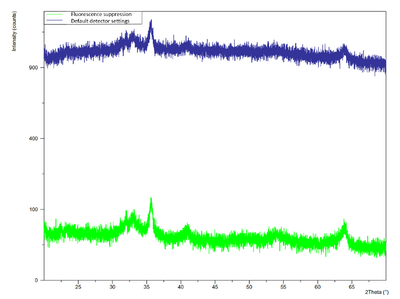Specific Process Knowledge/Characterization/XRD/XRD Powder/Measurement tips: Difference between revisions
| Line 17: | Line 17: | ||
Here is a comparison of a measurement with and without fluorescence suppression: | Here is a comparison of a measurement with and without fluorescence suppression: | ||
[[File:fluoresc supp feoh.png|400px|caption:FeOH measured with and without fluorescence suppression.]] | [[File:fluoresc supp feoh.png|400px|caption:FeOH measured with and without fluorescence suppression.]] | ||
Revision as of 16:15, 13 May 2024
Feedback to this page: click here
This page is under construction
Choosing measurement parameters
Some helpful tips can now be found in the manual on LabManager, section 4. They are mostly copied from the XRDMP Creater help document, which we for copyright reasons cannot make available here.
A detailed manual on the Aeris XRD is found online on the wiki of the International Ocean Discovery Project. It also has helpful hints on adjusting the hardware including choices on beam knife height and slit size. It also has some pictures from the XRDMP Creator software. A useful nugget of info from there which you will not find in our manual concerns the beam knife position: ..."Scanning at angles less than 5° 2θ you will need to lower the knife (anti scatter)."
Fluorescence suppression
It is possible to adjust the Pulse Height Discrimination levels of the Pixcel 1D detector on our machine. This can help suppress signal from fluorescence, which is at a slightly different energy level than the pure copper K-alpha signal. The exact energy level of the fluorescence of course depends on the material you are measuring.
Here is a comparison of a measurement with and without fluorescence suppression:


